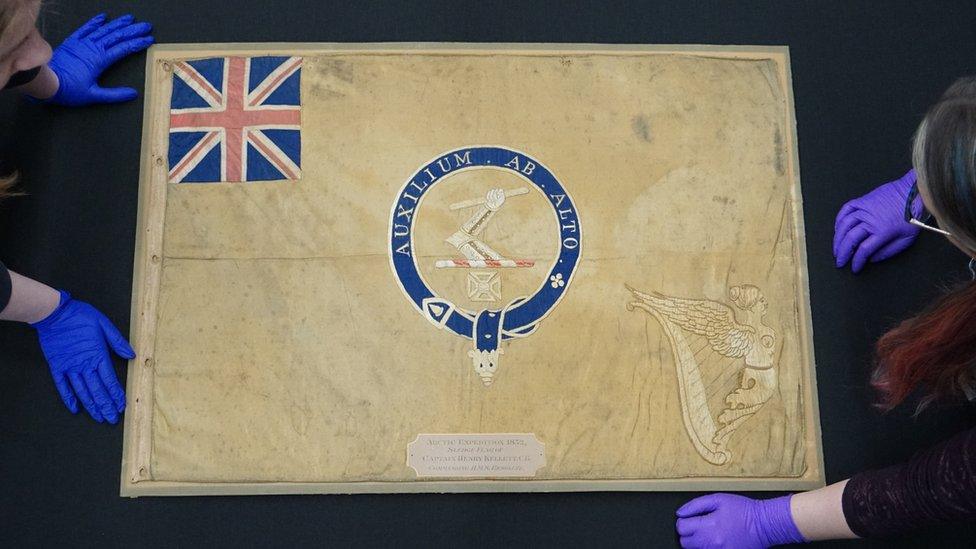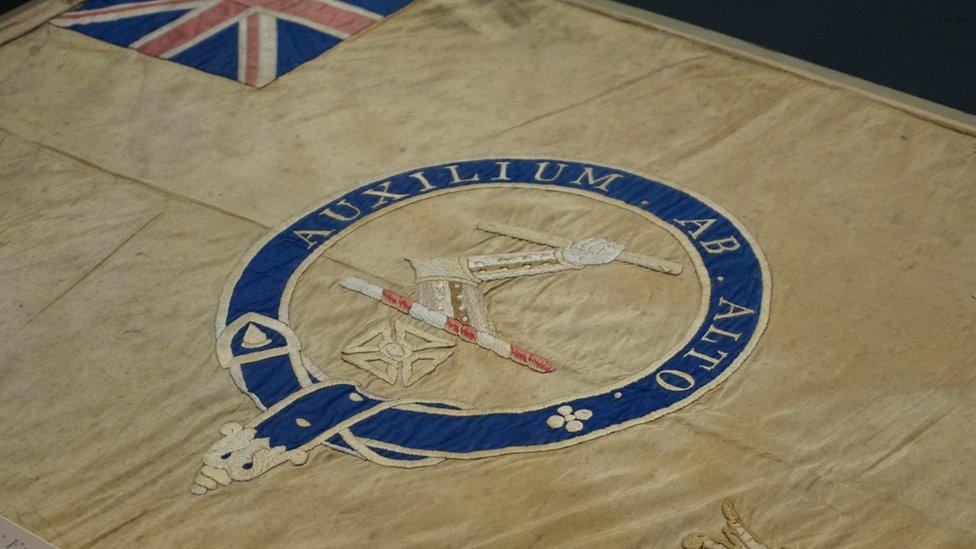Royal Navy Museum buys Irishman Henry Kellett's flag
- Published

Conservators from the National Museum with the Kellett flag
The rare polar sledge flag of a "proud Irishman" and notable 19th Century naval officer has been saved for the UK.
The National Museum of the Royal Navy (NMRN) bought the flag, stopping it from going into the hands of an overseas private collector.
The Kellett sledge flag was used to hunt for survivors of Captain Sir John Franklin's doomed expedition.
It was saved in a campaign backed by Michael Palin and Dan Snow.
It will now go on display in Hartlepool, Portsmouth and on the HMS Caroline in Belfast.
The flag belonged to Vice-Admiral Sir Henry Kellett, from County Tipperary, who led two Arctic expeditions to search for Sir John Franklin's lost ships.
HMS Erebus and HMS Terror disappeared with all their crew and were not found for more than 160 years.
The flag is made of green silk and embroidered with an Irish harp in golden thread to reflect Kellett's Irish heritage.
The NMRN launched a last-ditch bid to raise the £120,000 to keep the flag.

A close-up of the Kellett Sledge flag
It was made possible with help from the National Lottery Heritage Fund and the Art Fund.
The Kellett flag was flown during the third of a series of expeditions from 1852 to 1854 to look for survivors, or evidence of bodies, after Franklin's expedition.
Sir John Franklin led HMS Erebus and HMS Terror and 129 men on a voyage in 1845 to chart the Northwest Passage in the Canadian Arctic.
The expedition's disappearance shortly after became one of the great mysteries of the age of Victorian exploration.
The British government sent a number of ships to search for the expedition from 1848 to 1859 without success.

HMS Erebus and HMS Terror, as they appeared in Illustrated London News
Kellett led two searches, one aboard the famed HMS Resolute, which itself had to be abandoned in Arctic ice.
Timbers from the ship were later used to make the Resolute desk, which is used by US presidents in the White House's Oval Office.
HMS Erebus was found in 2014 and HMS Terror in 2016.
"Vice-Admiral Sir Henry Kellett's sledge flag and Franklin's expedition represent courage and fortitude in the face of adversity - core elements of our national identity that echo through our history," NMRN director general Prof Dominic Tweddle said.
"They also reflect the British and global obsession with finding and navigating the Northwest Passage, as well as the Royal Navy's role in expedition and exploration from Captain Cook to Darwin and HMS Beagle, to HMS Challenger in 1872, and continuing today with HMS Protector - the ice patrol ship in Antarctica and the Southern Hemisphere."
Charted new routes
The flag measures 595 by 885mm and is fragile. Any decision to clean the flag will have to balance the long-term preservation needs with the historical significance of the staining and ingrained dirt.
The museum spokeswoman said: "The green colour has faded over time due to exposure to light, but the flag remains in fairly good condition with a small crudely sewn repair that was likely done by a member of the search party whilst on the ice.
"The maker is unknown but the motto Auxilium Ab Alto translates to Help From Above."
Although Kellett failed in his mission to find the ships, he helped chart new routes through the Arctic.
The UK government imposed an export bar on the flag in September 2022 to allow time for a UK gallery or institution to buy it at the recommended price of £120,000.
Announcing the bar, the UK government described Kellett as a "proud Irishman" and a "famous Arctic explorer".